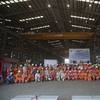As SOLAS Deadline Nears, More Composite Use is Expected
Director of Purchasing, Ocean Development Company
Composites have been utilized in various applications in the shipbuilding industry in order to meet countless requirements of shipyards and ship owners. Composites have found their way into areas such as hull design for smaller vessels to modular bathroom units on larger vessels. Research and development with composites has also created Trevira fabric.
Composites continue to evolve along with the shipbuilding industry, and one should expect to see more wide spread use of this material in years to come. In order to better understand composites one must review the creation of this modern material, and then one can examine the uses of this product.
The general definition for composite material is the combination of two or more materials in order to create a completely new material. For example, fiberglass, which is the combination of plastic resin and glass fibers, is a common composite. However, in the marine industry composites take on a completely different meaning. Composites in the marine industry refer to a material that has two outer layers with a core material that is sandwiched between these two layers.
In hull construction, composites are commonly two layers of glass and resin with a middle layer of either foam or balsa. In other applications, or where water intrusion is a concern, the core material can be aluminum or some other water impervious material. Composites can also be coated with fire retardant gel coats in order to meet USCG approval regarding fire resistance.
The use of composites continues to grow in the marine industry and composites have found some remarkable applications. Some of this rapid growth has been instigated due to the requirements set forward in the SOLAS 1992 amendments that pertain to passenger vessels. The SOLAS 1992 amendments require that by 2010 that all combustible material on passenger vessels be replaced with non-combustible alternates. This deadline has increased the use of composites in the shipbuilding industry as non-combustible alternates were necessary to meet various design requirements of engineers, architects and interior designers.
The use of composites has been further driven by the need by shipyards for materials that have a low cost of fabrication and installation, which makes the production costs of vessels lower, and the requirement of owners for vessel materials with greater long term durability. In many cases composites meet all these requirements. Despite these benefits, composites are not heavily used in the ship building industry in the United States. In general, overseas builders of commercial vessels have utilized composite construction more extensively. An example of the many uses of composites, Italian shipbuilder Fincantieri has used composites for the construction of ship stacks. These composite ship stacks have offered a reduction of weight by 50 percent, a significant amount when considering the impact to ship stability, as well as offering the shipyard a 20 percent cost reduction over traditional stainless steel and aluminum construction. Shipbuilders are also exploring composite deck houses, however this application is pending classification approval. Composites offer a practical alternative to many traditional shipbuilding materials. Composites offer the allure of reduced fabrication costs, reduced weight, while increasing durability. Although composites are utilized in hull designs of smaller vessels, the application of composites on larger vessels is much more limited. IMO and USCG both require that all composite material used in ship construction and outfitting to pass non-combustibility tests that measure flammability and the generation of smoke. Regulatory restrictions limit the use of composite material on large passenger vessels to non-structural applications. This restriction limits the scope of uses that composites can be used, however it still offers applications in many different areas. One widespread area of composite use is in the area of modular passenger bathroom units, or "wet units." These "wet units" offer the benefit of creating the unit in molds, allowing for identical units to be produced, rather than the individually built units. Since these bathroom units do not offer any structural support to the vessel, composite material is available for use in the construction of bathroom units. The advantage of these units over other methods is the ease of assembly within the vessel. Completed "wet units" are positioned into the vessel and affixed to the hull. Afterwards, electrical, water, and sewage hook ups are then attached to the ships man systems.
Another distinct advantage is that many composites are lighter than other building material. From a passenger perspective, these units offer a consistent appearance, while being easy to maintain by owners. These units resistant the typical wear and tear imposed by passenger, while retaining their luster over time. These modular units have been successful in application on passenger vessels, but also find limited use on trains and airplanes.
Another highly successful composite material in the marine industry is Trevira CS. This revolutionary fabric offers a highly durable, fire retardant material which meets the requirements of fire retardancy on passenger vessels. Trevira utilizes the same processes of creation as other composites, however Trevira is then spun into a thread or stripe and then is woven together in a variety of methods in order to mimic natural fibers. This material has found uses in upholstery, bedspreads, and wall coverings on passenger vessels. This remarkable material is as versatile as natural fibers, and can be used in almost every application in which cotton or wool can be used. Of course, this material is typically more expensive than other natural products, leading ship owners and ship builders to only utilize this material in applications that require fire-retardant material. Trevira CS fabrics are flame-retardant and do not degrade over time or change through the harsh chemical process of washing and drying. Trevira retains its fire resistance qualities due to these qualities being embedded at the molecular level. Hence the fire resistance of this material cannot be removed through any external process. Trevira will look exactly as it did when it was purchased, unlike other products that will fade, degrade, or disintegrate over time. Trevira CS continues to be an industry standard in the ship construction industry and will no doubt proliferate with the SOLAS requirements of 2010.
In the future, ship owners and ship builders can expect that the use of composite materials will increase in the future. Small vessel and large vessel owners alike are faced with the same economic pressures of demanding higher quality, with lower prices. These economic factors are clearing pushing research and development firms to create innovative applications of this material in shipbuilding and in other related construction industries. As long as the factors of safety, quality, and economy remain, composites will continue to find greater application in the ship building process.
Robert Lee Gordon is director of purchasing for Ocean Development Company and one of the world's most sought after projects - the building of the Project America cruise ships. Mr. Gordon is responsible for all the project-related purchasing of hotel and nautical engineering products for Project America, ms Patriot, Columbia Queen, and the Coastal Vessels.













